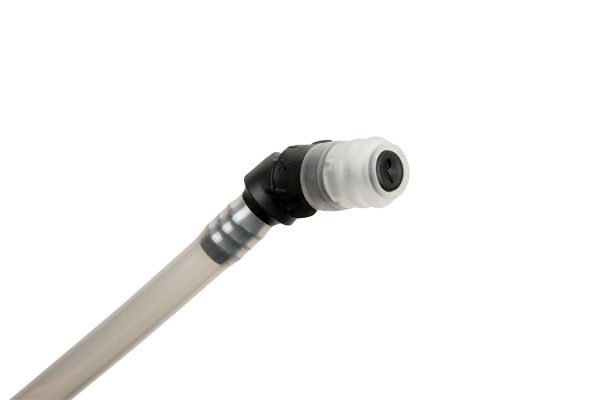Geigerrig Rig 700 Hydration Pack
 Hydration packs are based on a simple premise; the more convenient you make it for people to drink on the move, the more they will drink on the move. Over the past 15 years bladders have improved, mouthpieces have stopped leaking and the packs themselves have either become more functional, or too over engineered depending on your point of view.
Hydration packs are based on a simple premise; the more convenient you make it for people to drink on the move, the more they will drink on the move. Over the past 15 years bladders have improved, mouthpieces have stopped leaking and the packs themselves have either become more functional, or too over engineered depending on your point of view.
The Rig 700 landed on my back some months ago. The brand name sounds like the noise you make when you get a flat part way through a race; that sign of growling annoyance. Relatively new to the Australian market, this American brand has developed a hydration bladder that sprays water under pressure rather than requiring you to suck water out. This is achieved by using a double-chambered bladder. One chamber takes the water, the other is an air chamber that is pressurised via a bulb located on the shoulder strap. Pumping this bulb by hand forces air into the chamber, which puts pressure on the neighbouring water chamber and bingo, you’re on firefighting duty!
Hose Hoopla
The spray of water is only released when you bite on the valve or press it with your fingertips. This is no different to most hydration systems of course; the difference is the pressure that the water comes out at. The benefit here is that you can share drinking water without two people sucking on the same tube (although someone still needs to put their fingers on the mouthpiece to open it up). You can also use this ‘tap effect’ to clean things. On one ride a stick kicked up off the trail giving me a nasty leg cut. I used the spray to clean out the wound, which was certainly more efficient than the dribble you would get with most bladders.
Over the years I’ve tried numerous methods to clean the bike when mud turns to chocolate and clogs up the drivetrain, especially when you’re still a long way from home. Filling a bidon and squeezing it hard works well, but only when you’re close to a water source to keep refilling the bottle. On occasions I’ve even tried peeing on the drivetrain. You can get a decent head of steam and there’s the added benefit of the warm ‘water’ (this method doesn’t work as well for the ladies). Again, there is a limited supply of liquid. With the Rig you’ve potentially got two litres at your disposal and it provides a decent pressure spray to clean off the mud.

The pressurised water supply certainly adds a little extra functionality but the main improvement over a traditional bladder would be the ability to drink quickly without the need to suck—it’s a bit more like squeezing a drink bottle into your mouth.
The mouthpiece can be conveniently twisted to turn it off. This is actually pretty handy because if you accidentally press on the valve of most packs (you know, those times when you put the pack on the ground or in the boot of the car) you get a dribble of water; with the Geigerrig you get a full force spray!
Of course you don’t have to pressurise the bladder every time, as it can be used the same as a standard bladder. This is particularly the case when the pack is full of gear and you don’t have the room for the bladder to fully expand. The two-litre bladder used in the Rig 700 also has a wide opening allowing for easy filling, and more importantly very easy cleaning.
Beyond the Bladder
The Rig 700 pack itself is the second smallest in their current range with a capacity of 12 litres (Geigerrig also does 8, 20 and 25 litre packs). This size makes it suitable for long days in the saddle rather than trail blasts of a few hours.
Whilst comfortable enough, I did find the pack to have more zips and straps than was really necessary. This is however, an affliction for most brands now, adding features that are generally unnecessary. For example, the Rig 700 has two zips next to each other that access the same compartment. Fairly early in the review I also had a few plastic doodads fail (a zip toggle and the clip that keeps the hose on shoulder strap). Rigidity in the pack is provided by a large curved hard plastic plate, which makes a magnificent platter for those mid-ride lunch breaks, but really serves no purpose beyond that. I tended to leave it out of the pack as the substantial foam padding provides enough rigidity and the plastic plate just adds unnecessary weight.

While the Geigerrig system offers some benefits, I feel that you are paying a weight and price premium for the pressurised water supply. The Rig 700 retails for $160 for what is in essence a fairly average looking pack. If you see a need to share water, or wash your bike out on the trail, or want to guzzle lots in a hurry, then the Geigerrig system has real merit. If not, then you can get a pretty flash and well-designed hydration pack for less of your hard earned—it’s all about priorities and I’m sure some will see value in the well-executed pressurised bladder system.
Anyway, summer is now here and I’m looking forward to using my secret trail weapon. Sneak up next to mates on the trail, take aim and fire—now I can leave my water pistol at home!
Zen Imports (02) 8878 3600 / www.zenimports.com.au





